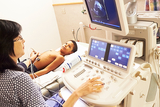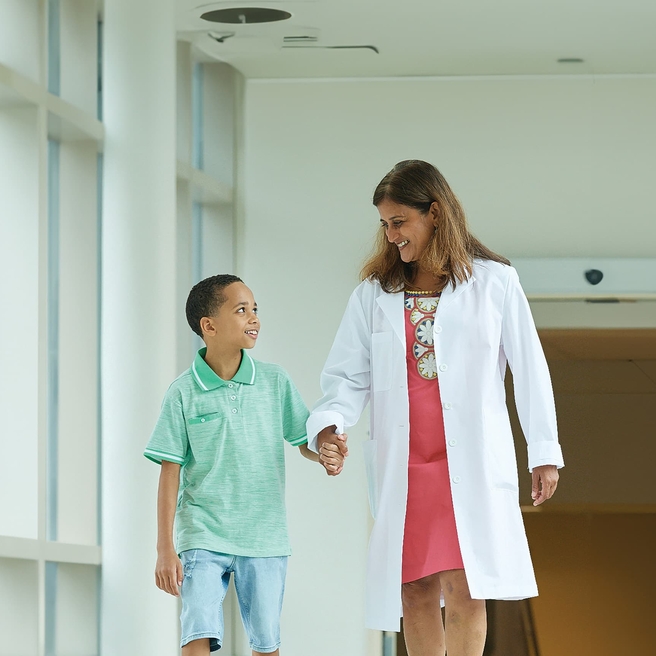What is aortopulmonary window?
The human heart has four chambers. The top chambers, the right and left atria, receive blood that flows into the heart. The bottom chambers, the right and left ventricles, pump blood out of the heart. In a healthy heart, the right atrium receives blood that has traveled through the body and has little oxygen left in it. The right ventricle pumps blood out to the lungs through a large blood vessel called the pulmonary artery. The blood picks up oxygen in the lungs, travels back to the left side of the heart and is pumped out to the body through a large blood vessel called the aorta.
An aortopulmonary window is a type of congenital heart defect in which a connection (or window) between the aorta and the pulmonary artery allows oxygenated blood to mix with deoxygenated blood. This puts extra pressure on the lungs and makes the heart work too hard. If aortopulmonary window isn’t treated, it can cause high blood pressure in the lungs (pulmonary hypertension) and lead to heart failure.
Signs and symptoms of aortopulmonary window
Aortopulmonary window symptoms vary depending on the size of the hole. In most cases, children will have symptoms in the first days or weeks of life, including:
- Rapid breathing
- Paleness or a gray color to the skin
- Not growing as expected
- Fatigue or irritability
- Heavy sweating
- Heart murmur, or abnormal heart sound when a doctor listens with a stethoscope
Testing and diagnosis of aortopulmonary window
Several different tests are used to diagnose aortopulmonary window after a baby is born. These include:
- Pulse oximetry, which is a noninvasive way to measure the amount of oxygen in the blood
- Electrocardiogram (EKG or ECG), which is a record of the electrical activity of the heart
- Echocardiogram (also called echo or ultrasound), which is when sound waves create an image of the heart
- Chest X-ray
- Cardiac CT scan, which is a special type of X-ray that provides a detailed image of the heart’s structure
Cardiac catheterization is sometimes needed, especially for babies older than 6 months who may have high pressure in their lungs. In this test, a thin, flexible tube (catheter) is inserted through a vein or artery in the leg and into the heart to provide detailed information about the structure and function of the heart and lungs.
Treatment for aortopulmonary window
Treatment for aortopulmonary window involves heart surgery to close the hole between the aorta and pulmonary artery. A heart surgeon uses a patch to seal the opening and stop the abnormal blood flow.
After surgery at Children’s Hospital of Philadelphia (CHOP), children will recover in the Evelyn and Daniel M. Tabas Cardiac Intensive Care Unit (CICU), where a team of dedicated cardiac critical care medicine specialists watch them closely day and night as they heal. They are then moved to CHOP’s Cardiac Care Unit until they are discharged home.
Outlook for aortopulmonary window
Thanks to huge advances in medicine and technology, most children with aortopulmonary window grow up to live healthy, active lives as adults.
Follow-up care for aortopulmonary window
Through age 18
After repair, most children recover quickly and don't have additional heart problems. Another surgery is rarely required. However, children with aortopulmonary window must see a pediatric cardiologist for regular checkups. Children who have other heart problems may need more frequent checkups and additional care.
Into adulthood
Our pediatric cardiologists follow patients until they are young adults. The Philadelphia Adult Congenital Heart Center, a joint program of CHOP and Penn Medicine, meets the unique needs of adults who were born with heart defects. At CHOP’s Cardiac Center, we support our adolescent and young adult patients through a smooth and seamless transition to adult cardiology care at the Philadelphia Adult Congenital Heart Center or, if desired, to a cardiologist with congenital heart disease expertise in another location.

Patient Outcomes at the Cardiac Center
Children’s Hospital of Philadelphia's pediatric heart surgery survival rates are among the best in the nation.
Resources to help
Cardiac Center Resources
We know that caring for a child with a heart condition can be stressful. To help you find answers to your questions – either before or after visiting the Cardiac Center – we’ve created this list of educational health resources.
